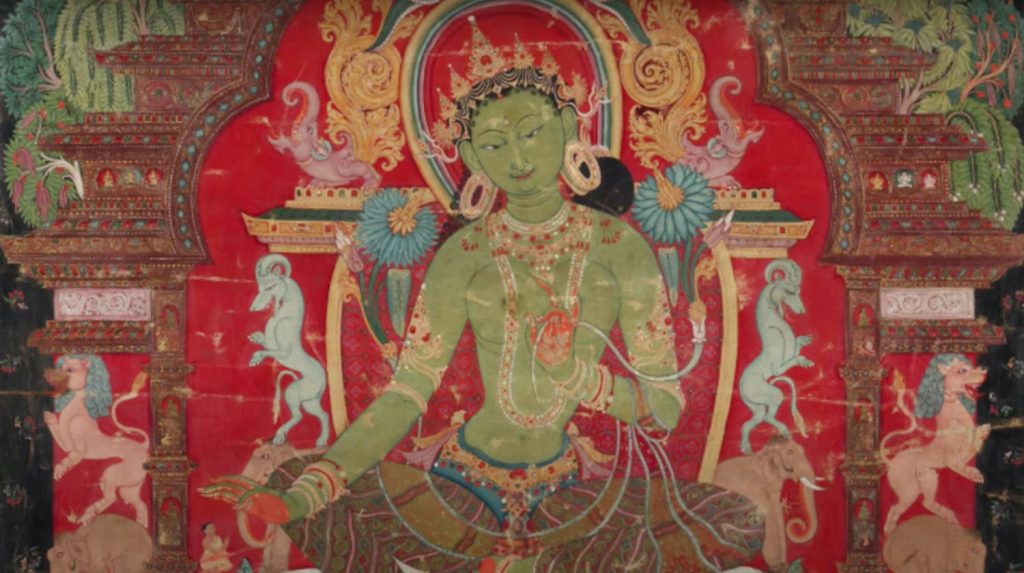Students and fans of Himalayan art know the Himalayan Art Resources website for its extensive catalog of artwork from Tibet, Nepal, Bhutan, India, China, and Mongolia, and the detailed information that accompanies each painting, sculpture, or textile. Known to many as HAR, the virtual museum and educational resource is approaching its 25th anniversary this September, and it recently added a new important resource tool to its roster: video. Two years ago, on June 9, 2020, when HAR Director and Chief Curator and professor Jeff Watt had to pause in-person teaching due to the pandemic, he started posting videos to YouTube, which also landed on HAR’s website. On June 9, 2022, he posted his 500th video. Tricycle caught up with Watt to learn more about the endeavor, and what’s next for Himalayan Art Resources.
How did this video project start? Were videos meant for your students or for a wider audience? Some videos were a little bit technical, and they were based on questions from students. Other ones were just very general, like a series on a particular deity or a series on religious hats and how to recognize them to be able to identify paintings or sculptures and what tradition they belong to. We started with questions, but expanded because we wanted to make more videos.
And now you’re up to 500 videos? We put the 500th video up on YouTube on June 9, 2022, but we actually have more than that, because we already have 16 or so videos up on our Patreon account.
Beyond answering questions for students, how do you choose the topics of the videos? A lot of the topics aren’t necessarily based on questions, but they’re based on discussions with students. For example, I have one student who’s very interested in the subject of Tara. So we’ve done a lot of videos on Tara because it’s also a very good generic deity that you can use to explain a lot of different things. You can explain a little bit of history, iconography, and tantric theory and function. Plus, there’s some very good art in museums or monasteries around the world that is quite well known, such as the famous Tara at the Cleveland Museum of Art. Some topics are very popular, and sometimes we choose topics because we think they’re important, but they get very few hits on YouTube. Other times we choose a topic because it’s a hole in the series that we want to fill.
Is there any type of order or progression? No, and we’re not using YouTube as the primary destination. If you go to the Himalayan Art Resources website, then all of these videos are cross-linked to all the subjects that relate to that topic. We view that as the primary destination because people who are going to the website and searching on a topic are the people who will benefit most from the videos.
Have you changed or updated your approach since the first video? Yes, it really has changed. And because we’ve reached 500 videos, we’re now pivoting to a new area. First, we’re going to slow down a bit on the free YouTube videos and we’re also going to come up with new techniques to make those videos quicker and a little bit easier. One approach is doing more site locations, where I’m just introducing the topic, and it’s the images that have to carry the video. What people don’t see behind the scenes is with some of these videos, and especially questions from students, I have to then go into the HAR website and update certain pages and make things clearer, or sometimes branch out and make more pages on that topic.
So that actually is a lot of work. A five- or six-minute video might actually take two hours, or even three or four hours, if I need to do more research, or if I really want to translate a Tibetan passage or something to add more depth to the subject.
Then, we want to pivot back to Patreon. We treat the Himalayan Art Resources website as the information conduit; it’s just the information. It’s like going to the library. But on Patreon we want to be more editorial. Also, on Patreon we can talk about auction houses and what art is coming up for sale, whether or not it’s any good, and whether or not they are sleepers—or art that’s undervalued that people don’t realize could be a tremendous asset to somebody. What are people not looking at? What’s really of value that’s hidden in the bottom of the box?
We’re also going to be devising some single 50-minute lectures on Teachable and eventually a three-lecture course to go a little bit deeper.
Explore HAR’s videos via its website or YouTube Channel, and check out the Patreon channel here.
♦
Join Jeff Watt for a conversation on decoding tantric art on July 28 at 4 p.m. EST. Register here.
Thank you for subscribing to Tricycle! As a nonprofit, we depend on readers like you to keep Buddhist teachings and practices widely available.
